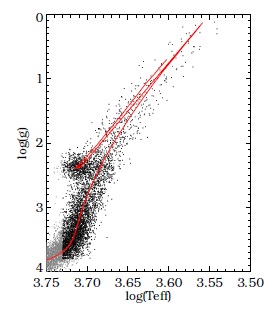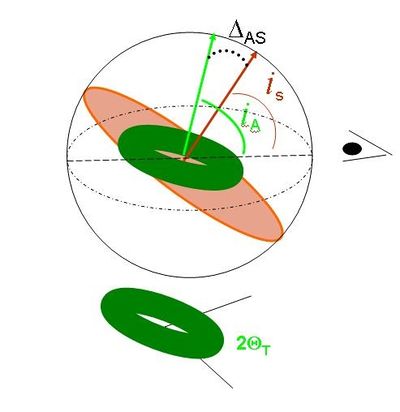Research highlights
Chemical evolution model of the MW, M31, nearby spirals and the local spiral population
Based on our pioneer chemical evolution model of the Milk Way(Chang et al. 1999, Hou et al. 2000), we further studied and compared the chemical evolution of the disks of the Milky Way (MW) and of Andromeda (M31), in order to reveal common points and differences between the two major galaxies of the Local group. We use a large set of observational data for M31, including recent observations of the Star Formation Rate (SFR) and gas profiles, as well as stellar metallicity distributions along its disk. We show that, when expressed in terms of the corresponding disk scale lengths, the observed radial profiles of MW and M31 exhibit interesting similarities, suggesting the possibility of a description within a common framework. We find that the profiles of stars, gas fraction and metallicity of the two galaxies, as well as most of their global properties, are well described by our model, provided the star formation efficiency in M31 disk is twice as large as in the MW(Fig 1, Yin et al. 2009[1]). Our chemical model has been successfully applied to the other individual local spirals, e.g. M33(Kang et al. 2012), UGC8802(Chang, Shen & Hou 2012[2]). Moreover, we further developed and applied this model to the whole local spiral populations (Chang et al. 2010[3]) and also embedded it in the semi-analytic models (SAMs) of galaxy formation and evolution(e.g, Fu et al. 2012, 2013).
Figure 1. Current profiles of gas, stars, SFR, gas fraction, and oxygen abundance for MW and M31. Observations are presented as shaded areas and model results by solid (for the MW) and dashed (for M31) curves, respectively.
Discovers and insights from LAMOST
Three dimensional Galactic dust distribution
Using a sample of over six million stars from LAMOST spectral survey, our study shows that the overall distribution of the interstellar dust in the Milky Way can be well described by a disk-like structure with an exponential decrease in both radial and vertical densities, after subtracting two very prominent substructures near the sun. The scale-length of the dust disk is up to 10,000 light-years, while the scale-height is only about 330 light-years. In contrast to the structural parameters of the Milky Way's stellar disks, also based on LAMOST survey data, the Galactic dust disk is also more stretched on the radial scale and thinner in the vertical. That is to say, if we are far enough away, the Milky Way we see will be very similar to Sombrero Galaxy from the edge-on view. (Li et al. 2018 ADS)
Hyper-velocity stars
Hyper-velocity stars(HVs) are useful probes of both the Milky Way potential and of stellar populations in the inner galaxy. Identifying HVSs requires large spectroscopic surveys such as LAMOST or SDSS. The first bona-fide HVS was identified by Zheng Zheng from Utah (Zheng et al. 2014), but we are carrying out complimentary studies at SHAO. Nearby HVS will be particularly valuable as we can accurately determine their full three dimensional positions and velocities, hence allowing us to constrain the Milky Way potential. Zhong et al. (2014[4]) have discovered a number of nearby high velocity stars, some of which appear to have velocities in excess of the local escape speed. A complimentary study was carried out by visiting student John Vickers (ARI, Heidelberg, Germany); while at SHAO he worked in collaboration with Martin Smith on a project analysing candidate HVSs from SDSS. The resulting paper (Vickers et al. 2014) presents both HVS candidates and also Hills candidates, i.e. metal-rich HVS stars which have orbits consistent with Galactic centre ejection. Work in this field is continuing at SHAO, with Martin Smith and student Yanqiong Zhang who are now looking for further Hills candidates in SDSS by combining high-precision proper motions from Stripe 82 (Bramich et al. 2008) with new spectroscopy from the 200 inch telescope at Palomar.
Milky Way halo
LAMOST is also a valuable resource for studying the stellar halo. Using samples of spectroscopically identified K-giants (Liu et al. 2014) or M-giants (Zhong et al., in prep), we are able to trace the Sagittarius tidal stream across large areas of sky. Importantly, the coverage of LAMOST is significantly larger than SDSS, enabling us to trace the stream in previously unexplored regions such as at low latitudes (Li et al., in prep; see Fig 2). Deep photometric surveys are also important for studying halo substructures. Together with Jundan Nie at NAOC, Martin Smith is using the Chinese u-band SCUSS survey to look at the outer halo using blue horizontal branch stars. For the first time we are able to constrain the spatial extent of the Pisces over-density (Nie, Smith, et al., in prep), finding that it covers a huge area on the sky.
Figure 2. Sagittarius stream debris observed from LAMOST using M-giants (Li et al., in prep). The tails are seen extending from the core of the Sagittarius dwarf (located at RA = 280 deg, Dec = -30 deg) and can be traced around the entire sky.
Milky Way disk
The Milky Way’s disc also can also tell us about the evolution of our galaxy. Kinematic substructures in the outer disc have recently been found (Liu et al. 2012), but the origin remains unknown. Together with Juntai Shen, Martin Smith and his student Matthew Molloy (PKU) are investigating the predictions of an N-body simulation (Shen et al. 2010) in order to understand the mechanisms which can cause such substructures. Molloy et al. (2014) shows that such signatures can arise when stars fall into resonance with the Milky Way’s bar, leading to transient features in the outer disc. This scenario makes predictions which will be tested further using surveys such as LAMOST or APOGEE.
Ages of stars
If we want to dissect the formation history of the Galaxy, we ideally need to know the ages of the stars we are studying. Ages are notoriously difficult to determine, but with precise stellar parameters from high-resolution spectroscopic surveys, such as APOGEE, this is becoming possible. SHAO postdoc Emma Small is working on developing tools to estimate ages for red giant and red clump stars (Fig. 3). The resulting catalogues, which combine ages with the detailed kinematics and chemistry, will allow us to probe the formation histories of the disc, bulge and halo.
Figure 3. This figure demonstrates how we are determining star formation histories from spectroscopic surveys such as LAMOST or APOGEE (Small et al., in prep). We have generated a mock population of stars (left) with measured stellar parameters (e.g. gravity, temperature, metallicity), and used these to recover the underlying star formation history (right; red shows the input history, black shows the recovered one).
Stellar population and structure of galaxies
color-magnitude relation of nearby galaxies
We use compile a large sample of galaxies drawn from the Sloan Digital Sky Survey (SDSS) and Two-Micron All-Sky Survey (2MASS) to present colour-magnitude relations (CMRs) for both early-type and late-type galaxies in both optical and optical-infrared (optical-IR) bands.
For early type galaxies, We compare the correlations between optical, optical-infrared and infrared colours and galaxy luminosity, stellar mass, velocity dispersion and surface mass density. We find that all galaxy colours correlate more strongly with stellar mass and velocity dispersion than with any other structural parameter. The dispersion about these two relations is also smaller. We also study the correlations between a variety of stellar absorption-line indices and the same set of galaxy parameters and we reach very similar conclusions. Finally, we analyse correlations between absorption-line indices and colour. Our results suggest that the optical colours of elliptical galaxies are sensitive to a combination of age, metallicity and alpha-enhancement, while the optical-infrared colours are sensitive to metallicity and to alpha-enhancement, but are somewhat less sensitive to age(Chang et al., 2006a[5])
For late type galaxies, we find, after correcting the dust attenuation, the optical colours for faint galaxies (i.e. Mr > -21) have a very weak correlation with the luminosity, whereas the optical colours for bright galaxies (i.e. Mr < -21) are redder than those for more-luminous galaxies. All (optical, optical-IR and IR) colours show similar but stronger correlations with stellar mass than with absolute magnitude. The optical colours correlate more strongly with stellar mass surface density than with stellar mass, whereas optical-IR and IR colours show stronger correlations with stellar mass. By comparing the observed colours of our sample galaxies with the colours predicted by stellar population synthesis model, we find that massive late-type galaxies have older and higher-metallicity stellar population than that of less-massive galaxies. This suggests that CMRs for late-type galaxies are trends defined by the combination of stellar mean age and metallicity. Moreover, our results suggest that the stellar mean metallicity of late-type galaxy is mainly determined by its stellar mass, whereas the star formation history is mainly regulated by the stellar mass surface density(Chang et al., 2006b [6])
inclination of spirals
Dust opacity in spiral disks can be probed by studying the average photometric properties of spiral galaxies as a function of disk inclination angle, as first suggested by Holmberg (1958, 1975). we use the SDSS galaxy sample to study dust extinction in spiral galaxies. Our analysis is based on the luminosity function (LF) of galaxies as a function of inclination angle. We find that the characteristic luminosity of the LF, L*, decreases with increasing inclination, while the faint-end slope, alpha, depends only weakly on it. The inclination dependence of the LF is consistent with that expected from a simple model in which the optical depth is proportional to the cosine of the inclination angle. Using the dust extinction for galaxies obtained by Kauffmann and coworkers, we derive an extinction-corrected luminosity function for spiral galaxies. Dust extinction makes M* dimmer by ~0.5 mag in the z band and by ~1.2 mag in the u band. (Shao et al. 2007[7]).
On the other hand, it is very interesting that the inclination of the spiral disks is statistically correlated with the AGN type. It is found from the SDSS galaxies that the type II AGNs are more likely to be hosted by the edge-on galaxies(Fig. 4). Besides the extinction from the host galaxies, this result implies an intrinsic correlation between the very inner accretion disk and the host stellar disk(Shen, Shao & Gu, 2010[8]).
Fig. 4. The cartoon of the tilt angle (ΔAS) between the accretion disk (inclination: ΘS) and stellar disk (inclination: ΘA ) of a type 2 AGN (90○-ΘA <ΘT).





